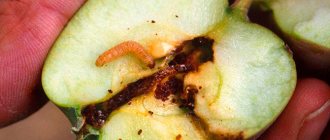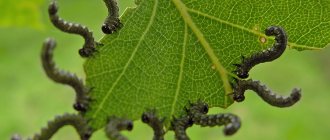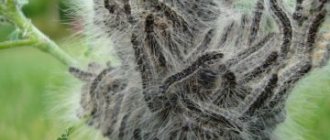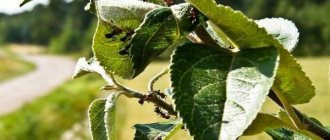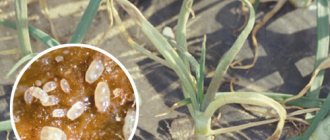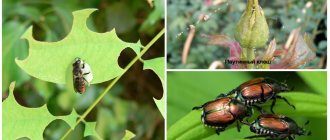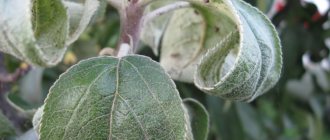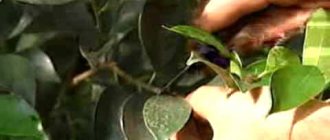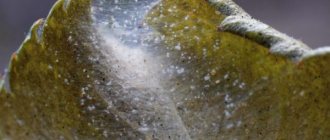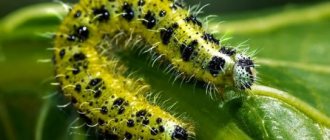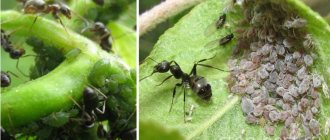Apple trees, if properly cared for, produce a bountiful and tasty harvest. Depending on the variety, the fruits can be sweet or sour, winter or summer. You just need to provide the plant with proper care so that nothing overshadows the joy of harvesting. Caterpillars on an apple tree can greatly harm the tree, including loss of harvest. It is necessary to know the pest “by sight” and how to deal with it.
Caterpillar on the trunk of an apple tree.
Description of the pest and habitat
Caterpillars belong to the order Lepidoptera and are the larvae of moths or butterflies. They can feel comfortable on any fruit and berry trees and shrubs, and can easily migrate over long distances.
Their peculiarity is their amazing gluttony. A population of these individuals can very quickly destroy leaves on any plant. However, they are not picky and will happily feast on fruits or even bark on a young tree.
It is very important to recognize the signs of a pest on an apple tree in time. Some of the representatives of the caterpillars lead an open lifestyle, but some are also quite secretive.
Web
The web may be evidence of the emergence of different types of caterpillars. But it is necessary to accurately determine whether the web is their work, because if it is light and delicate, located closer to the ground, then these are most likely ordinary spiders and they do not harm the plantings.
But the web from the appearance of caterpillars can be light and thin. There are always crumpled and curled leaves on it, where the pest settles down for the night. When the canvases are large, often accompanied by completely corroded branches, practically without leaves, then it is necessary to immediately proceed to immediate action.
The following pests can be found on apple trees:
- lacewing;
- hawthorn;
- winter moth;
- apple ermine moth;
- gypsy moth.
The type of pests will determine what methods will need to be used to combat them.
Larvae under the bark
These pests are the most dangerous because they do not show up right away. The larvae can remain under the bark undetected for a very long time, causing harm to the apple tree. They make their moves there, which is why the plant suffers. This creates a risk of fungal disease or infection.
Caterpillar larva under the bark of an apple tree.
You can only notice the appearance of these hidden pests on an apple tree if you carry out regular inspection. It is usually easy to see the remains of traces of vital activity, near which there will definitely be an entrance under the bark.
The following hidden pests can live under the bark of an apple tree:
- corrosive woody wood;
- odorous woodborer;
- apple glass;
- eastern codling moth.
It is better to inspect the bark several times a season to prevent the appearance of caterpillars.
In the buds of apple trees
Caterpillars that settle in the buds and leaves of apple trees are at greater risk because they are more visible. However, they cause much more harm, since they destroy flowers and leaves, thereby directly reducing the amount of harvest. By interfering with flowering, they prevent the ovaries from appearing and can completely destroy the entire future harvest.
Most often the buds are inhabited by:
- hawthorn;
- leaf roller;
- apple moth.
Even if some ovaries have already formed and the fruits begin to ripen, these caterpillars happily eat the fruits.
Microbiological preparations
It is worth fighting with special drugs
Folk remedies are ineffective against large numbers of pests, so it is recommended to use biological preparations. They are safe for humans, animals and bees, but are fatal to insects.
The only limitation is that they can only be used in dry weather at temperatures above 15°C.
The most effective:
- Lepidocide;
- Fitoverm;
- Bitoxibacillin;
- Dendrobacillin;
- Entobacterin;
- Bicol;
- Verticillin.
Fitoverm is considered the best biological product. However, it has toxic components that are lethal to fish. Therefore, it cannot be used near bodies of water.
But it starts working at 18°C and doubles its efficiency at 25°C.
It is important to carry out regular treatments (2-3 times per season), and the fruits can be consumed already on the 3rd day after the procedure.
Unfortunately, biological products have no effect on ticks and do not work well on aphids.
Caterpillars on an apple tree, how to fight
Insects on the apple tree must be dealt with immediately. They are voracious and can quickly develop surrounding territories. Therefore, there are a number of tools that can help in this battle.
Folk remedies
The products, tested by time and experience of the people, are environmentally friendly and do not pose a threat to other insects and birds. In addition, they are also inexpensive, because they use improvised means.
The simplest remedy is water. Using a hose with strong pressure, you can wash away pests, then collect them and destroy them. This option is the most economical and simple. In addition, there are also various decoctions and infusions.
Celandine
Dry celandine leaves must be filled with water and left for two days for the infusion to prepare. For one bucket of water, take a glass of dry leaves. Before spraying, you need to strain the solution and add a little soap, liquid or grated laundry soap.
Celandine leaves and flowers.
You can also prepare a decoction. To do this, you need to take 200 g of dry matter per liter of water and boil for 15 minutes. It is better to boil it in a water bath so that the properties of the plant are better preserved. When the finished broth has cooled, it needs to be strained and diluted in a bucket of water. Add soap before spraying.
Fresh grass is also used. You can wrap some green shoots of celandine around the trunk and tie it. This kind of belt will help protect the tree from the codling moth. The grass will need to be replaced as it fades.
Decoction of tomato tops
Tomato tops are a universal remedy for combating various insects that harm leaves. It is only important to prepare the decoction correctly to protect the apple tree. You need to collect a kilogram of fresh tomato tops, place them in a bucket and fill them to the top with water. Leave the mixture for five hours, then simmer for three hours over medium heat. Strain and add water to the remaining liquid in a ratio of 1:2.5.
Sagebrush
Wormwood is used to protect apple trees in various forms. Leaf-eating caterpillars are destroyed by a decoction of wormwood. It is prepared from a kilogram of dried flowers per liter of water, which must be boiled for 15 minutes. The resulting broth is filtered and diluted in a bucket of water, used for spraying.
An infusion will also help against the codling moth. But to prepare it you need to take wormwood, which is in bloom. Fresh grass is cut into a bucket so that there is half of it, pour 10 liters of boiling water and leave for a day. After this, you need to boil the liquid for half an hour. Before spraying, dilute the infusion with water in a 1:1 ratio.
Soda
A simple remedy can help save apple trees from leaf-eaters. Soda can be used dry or as a solution:
- Dry soda is mixed with ash or flour and used for dusting.
- To spray, you need to dissolve 3 tablespoons of soda in a bucket of water.
Preparing a soda solution.
But there are some rules that must be followed for the baking soda to work:
- You cannot prepare a soda solution in metal, plastic or aluminum containers. It is prepared only in glass containers;
- use the prepared solution immediately, and if you need to store it, then no more than three hours;
- The treatment must be carried out in dry, windless weather, in the morning or evening, because in the heat soda loses its properties;
- It is important that the container in which the solution is prepared is clean, as is the sprayer. Any impurities can have a detrimental effect on the properties of soda.
Only by adhering to these rules will treatment with soda help destroy pests from apples.
Birch tar with soap
Tar made from birch bark is an excellent natural remedy for protecting apple tree leaves from caterpillars. It acts differently on different pests, but the protective agent is prepared in the same way.
To do this, you will need 10 g of birch tar and half a bar of laundry soap per bucket of water, which needs to be dissolved.
You need to apply it like this:
- For codling moths, pour the solution into several plastic bottles and hang it around the crown.
- For hawthorn - spray cocoons and dry tips of branches with tar solution, and then the entire crown of the tree. It is also necessary to process the tree trunk circle.
You need to understand that folk remedies will not completely destroy caterpillars on an apple tree right away. The treatment should be repeated after a few weeks, but it is better to combine it with mechanical destruction of the pest population.
Birds are also an excellent way to control caterpillars. They can be lured to the site to make them feel comfortable.
Chemicals
Chemical preparations are good because they provide complete protection against caterpillars. But many beneficial insects also suffer from them, so application requires strict control and adherence to instructions.
Intavir
The drug is of synthetic origin and contains cypermethrin, which has a paralyzing effect on pests. It is sold in dry form: tablets or water-soluble powder.
Powdered pest control Intavir.
The drug is quite toxic to people, so treatment must be carried out strictly in a protective suit. The solution should not be used during flowering and fruiting so that pollinating insects do not suffer from it and the substance does not accumulate in the fruits.
Abundant spraying will help protect the tree from codling moths and leaf rollers. But you should not use intavir too often, because it is addictive.
Tanrek
The active substance of this insecticide is imidacloprid. It is sold as a water-soluble concentrate. You need to use 3 ml of the substance per bucket of water, consumption per tree is 2.5 liters.
The effect of the drug is that it penetrates the caterpillar’s body through tissue and paralyzes it. Because of this, the pest cannot feed and dies. The drug affects larvae and adults; one treatment is enough for 3 weeks.
Tanrek should not be used during flowering and fruiting because it harms bees and can accumulate in the fruit. Chronic use is also prohibited because it can be addictive. People need to use protective equipment.
Fufanon
This organophosphate insecticide contains the active ingredient malathion, which quickly penetrates the caterpillar's body and infects it. It is produced in the form of an emulsion with virtually no odor. A bucket of water will require 10 ml of the product; for one tree you will need to use 2-5 liters of the working solution.
Trees are treated twice per season, avoiding flowering and fruit harvesting times. The effect applies only to adult individuals; the larvae are not destroyed. Fufanol affects the digestive tract, poisoning the caterpillar, which causes death.
Kardofos
The drug is available in different forms: tablets, powder or granules. The composition contains a high content of malathion, as a result of which the death of the insect occurs immediately after contact.
For an adult apple tree, 10 liters of working solution will be needed. Spraying is carried out no more than three times per season, skipping the time of flowering and fruit ripening.
Insect and pest repellent Cardofos.
The drug has an extremely unpleasant odor and is toxic, so processing the apple tree must be carried out in a protective suit and a respirator.
These chemicals will help get rid of pests right away. But they have side effects such as addiction and toxicity. Whether to use them or not is up to each gardener.
Prevention
Prevention is very important in the fight against small pests, because it is always easier to prevent a problem than to deal with its consequences.
Installing a trap for pest butterflies.
Preventative measures include:
- regular weeding of the soil around the apple tree;
- elimination of root shoots;
- proper fertilizing of crops;
- timely pruning;
- regularly inspect trees for damage;
- treatment of cracks and wounds.
Another method of biological control of caterpillars is to attract their natural enemy - birds. This issue can be solved simply by installing feeders on the site.
Species diversity of caterpillars
In order not to list the huge species diversity of these pests, they are conventionally divided by shade.
Black
Black caterpillars on apple trees feed not only on leaves, but also on flowers or ovaries. The most common thick, shaggy black caterpillar, 7 cm long, is the gypsy moth.
In June, the caterpillars form cocoons, and a month later the butterflies appear. They reproduce very actively and can lay about 1,000 eggs, which can be found on the lower parts of the leaves.
Black caterpillars on an apple tree.
The clutch of eggs and cocoons must be removed, and then the apple tree must be treated with a special preparation. For prevention, you will need an insecticide, which should be sprayed before flowering.
Hawthorns are yellow with black stripes, no more than 5 cm long. Cocoons on cobwebs begin to appear in late May - early June. At the same time, it is necessary to carry out protective spraying against them. Characteristic features of the settlement of this type of caterpillar on an apple tree are eaten leaves, but the veins remain intact.
Gray
The ringed silkworm looks like a gray caterpillar with blue stripes. The insect does not do much harm to trees, because it rests in the web during the entire daylight hours. A small population can be easily destroyed using folk remedies, and large colonies can only be destroyed with the help of Karbofos, Bitoxibacillin or Lepidoicide.
Gray caterpillars on an apple tree.
Greens
The winter moth is a small green caterpillar that causes a lot of damage. It lays eggs in almost all parts of the tree: in flowers, buds, leaves, which are completely wrapped in cobwebs.
You can protect the apple tree from the invasion of these pests mechanically, by removing places where they accumulate, and with the help of folk remedies. Temperatures of -35⁰С are detrimental to pests.
Green caterpillars on an apple tree.
The well-known leaf roller is also green. It is small, so it is quite invisible, but it causes a lot of damage. The caterpillar infects buds, buds and leaves. In July, their population can be seen by tubes of leaves that are wrapped in a web. They can be destroyed with a solution of tar and soap or insecticides.
White
This list also includes white and pink caterpillars, which are represented by the codling moth or glass moth. They are small in size, but there are a lot of them on an apple tree.
And the fruit striped moth, which often settles on leaves and shoots, can also be white and pink. They reproduce very quickly; 2–3 generations can pass in a season. They settle densely on green shoots and destroy young leaves.
White caterpillars on an apple tree.
The eastern codling moth has a pink body with a whitish tint. She is very small, up to a centimeter in length, but very prolific: she lays about 300 eggs.
Codling moth caterpillars
This living creature is very dangerous and attacks wood and fruits. Pests lay eggs after flowering on the ovaries and leaves, then quickly grow and feed on the fruits.
Codling moth caterpillars on an apple tree.
The codling moth is destroyed using insecticides, but trapping belts often help.
Apple glass caterpillar
This small caterpillar is white and yellow in color and only infects apple trees. It can make its moves under the bark and on the branches so abundantly that the branches can even die off.
Apple glass caterpillar on leaves.
Glass often penetrates through cracks and damage to the wood. If trees are treated correctly and promptly with insecticides, then the risk of infection is minimal. Whitewashing is also a good preventative measure.
Yellow
Dirty yellow small caterpillars with black dots around the perimeter are apple moths. They cause great damage to the crop if they are not dealt with in time. Caterpillars settle in large colonies and form entire nests in the web.
Yellow caterpillars on an apple tree.
There are several ways to identify the action of caterpillars on an apple tree:
- externally discovering a large amount of cobwebs on the green parts, flowers and buds;
- examining the cortex, where there will be entrances and exits, as well as waste products.
Regular inspection of apple trees and systemic spraying will help avoid infestation with caterpillars.
Methods for eliminating codling moths
Codling moth (lat. Cydia pomonella)
Codling moth is the most common type of pest. They attack the fruits, preventing them from fully ripening. Lives within the distribution range of apple and pear trees. How to deal with the pest:
- collecting fallen apples, destroying them together with caterpillars;
- regular cleaning of the bark, laying out hunting belts;
- the use of insecticides to spray trees at the end of flowering, the best option is chlorophos (0.2%), karbofos (0.3%).
Before treating the entire garden, it is better to spray only 1 crop. This is necessary to check the effectiveness of the solution.
Terms of work
There are several stages of work carried out in the garden at the right time.
Before sap flow begins
The first work is carried out even before the kidneys begin to wake up. But the ambient temperature must not be lower than -5⁰С.
You need to do:
- Visual inspection of the apple tree.
- Collect and destroy all the masonry from the web.
- Inspect the bark, open all passages and holes.
- Treat the tree with insecticides and copper sulfate.
After these procedures, the young buds will be protected from caterpillars.
Before flowering
The next treatment of the apple tree is carried out when the buds have already woken up, but flowering has not yet begun. During this period of time, it is necessary to destroy the caterpillars that love to feast on young growth.
It is necessary to spray with preparations containing copper and organophosphorus insecticidal preparations.
Treating an apple tree against caterpillars.
During flowering
It is advised not to use chemicals during flowering so as not to reduce the number of ovaries. These substances have a detrimental effect on beneficial insects that carry out pollination.
If the situation is very dire and intervention is necessary, you can use Bordeaux mixture and karbofos. But it is better to use folk remedies that will not cause much harm to beneficial insects.
After flowering
When the apple trees have bloomed, they should be treated again for caterpillars. But you can spray only those varieties that are at least a month away from ripening.
It can be treated with chemicals or folk remedies. At this time, it is important to combat the codling moth.
During fruiting
Although there are chemicals that decompose quite quickly, it is better not to use even them so as not to risk your health. During the fruiting process, you can only manually collect and destroy large hordes of pests.
After fruiting
When the entire harvest is harvested, the trees need to be properly prepared for winter. At this time, several procedures are carried out:
- collecting and burning fallen leaves;
- digging and treating the tree trunk with insecticides;
- tree pruning;
- treatment of wounds and whitewashing.
These measures will help destroy the remaining pests and not leave them a chance for a warm, comfortable winter.
Chemicals
Spraying an apple tree with chemicals also harms beneficial insects, so it is better to use gentle folk remedies in a timely manner and prevent mass reproduction of caterpillars.
- Intavir . Acts on the nervous system of pests, leading them to paralysis. Available in powder or tablet form. Use immediately after preparation. Requires the use of protection (mask and gloves). Toxic, especially to fish and bees.
- Tanrek . An organic insecticide that affects parasites through plant tissue. Non-toxic. It is resistant to moisture and has the same effect on both larvae and adult caterpillars. It is also used in conjunction with protective equipment.
- Fufanon . The active ingredient is malathion. It is a contact-intestinal emulsion. Toxic. The death of pests occurs within 10 days after application. Does not have an unpleasant pungent odor.
- Karbofos . Also contains malathion. Provokes instant death of parasites. Available in different forms: tablets, powder, granules. Not used during the flowering period and later than 3 weeks before the first fruiting.
Useful tips
Don't think that a few leaves on a tree don't matter and you can ignore their infestation. The entire tree functions as a full-fledged organism, so damage to any of its organs will cause a weakening of the immune system.
And the impact of caterpillars on apple trees should not be underestimated either. They multiply quickly and eat various parts of the tree, causing irreparable damage to it. Even if they are not present at the moment, it is better to periodically check the crown, because they can appear completely by accident and quickly begin to act.
Carrying out preventive measures in the garden
Experienced gardeners believe that it is easier to prevent caterpillars from appearing than to exterminate them. To do this, the following preventive measures should be taken:
- carry out a systematic inspection of the bark, burning of discovered nests with cobwebs, as well as leaves damaged by insects, ovipositors;
- treat the trunk with biological preparations (for example, Endobacterin);
- hang feeders and birdhouses in the garden to attract birds, because birds willingly eat caterpillars and other parasites. Tits and starlings on the apple tree readily feed on caterpillars;
- do not forget about whitewashing plants.
Knowing how to deal with caterpillars on apple trees, you will be able to select a set of measures that will allow you not only to eliminate the pests, but also to prevent their reappearance in large quantities. The right approach guarantees a bountiful harvest.
Venturia inaequalis or Venturia unequal
The infestation of apple trees with scab is the result of the work of the marsupial fungus Venturia inaequalis (Venturia unequal).
Parasitizing the vegetative mass of an apple tree, the fungal infection attacks leaves, shoots, flower buds and fruits. The active reproduction stage begins in early spring, when the spores of the fungus awaken and infect the young leaves of the apple tree.
As the fungus develops, it spreads throughout the plant, and rain and wind help it move to neighboring fruit trees.
Venturia unequal overwinters on fallen leaves, bark and unripe fruits. Under comfortable climatic conditions, the marsupial fungus can successfully survive the winter in the soil.
Result of infection.
Causes of infection
To successfully fight scab, you need to understand what conditions create a comfortable environment for the development of the parasitic fungus.
- A favorable factor for the development of infection is high humidity, at which spores actively grow;
- The ideal temperature for the development of the fungus is in the range from 18 to 20 degrees Celsius;
- Poor ventilation of the crown and its excessive density are optimal conditions for complete destruction of the apple tree;
- Condensed plantings increase the risk of rapid spread of infection from one tree to another.
Apple trees are most vulnerable to scab infection in the second half of May, when flowering begins.
Excessive crown density.
Signs of the disease
You can find out whether an apple tree is infected with scab by the characteristic signs of the disease:
- Light green spots on the leaves, oily initially, brown velvety as they develop;
- Dark spots appear on the apples, and at the final stage they crack;
- The bumps on the bark crack towards the end of the season, releasing new fungal spores.
Scab is dangerous because it can form a fruitful symbiosis with other pathogenic fungi. The apple tree is affected by a whole range of diseases.
ATTENTION! Along with scab, powdery mildew and Alternaria can develop on the apple tree. Signs of scab
Consequences
Apple trees will not die from infection with marsupial fungus.
Moreover, the longer the apple tree lives, the better for the parasite, because the development of the tree contributes to its vital activity and spread.
The tree’s body suffers and weakens:
- Scab, absorbing leaves, causes them to die, making it difficult for the plant to breathe and absorb nutrients;
- Severe infection can lead to premature leaf fall, the apple tree will not be able to properly prepare for wintering;
- Shoots that have wounds and cracks from scab do not bear fruit the next season;
- With severe damage, when flower buds and ovaries are infected, the apple tree does not produce a harvest;
- The taste qualities of apples deteriorate, and their presentation does not allow for their successful sale;
- Infected fruits cannot be stored for a long time, which is especially true for winter varieties of apple trees.
Timely therapeutic and preventive treatment of apple tree scab will improve the health of the orchard and reap a rich harvest.
Biology guards your garden: birds and insects against aphids
To prevent aphids from annoying your garden, you need to call insects and birds, which are the main enemies of pests, as allies. The most harmful to aphids are:
- ladybugs, and especially their larvae;
- lacewings;
- ground beetles;
- hoverflies;
- predatory bugs;
- wasps;
- sparrows;
- kings;
- warblers;
- tits;
- wrens;
- linnets.
In order to attract insects that destroy aphids to your site, plant spicy and aromatic plants: dill, parsley, cloves, carrots, and nettles. Ladybug is very fond of calendula, which will also help decorate your garden.
Ladybug is one of the main enemies of aphids
Birds mainly feed captured aphids to their chicks. To attract birds to your site, install feeders, birdhouses and drinking bowls in accessible places.
Many plants have properties that either repel or attract aphids. This can also be used to kill pests.
Plant flowers such as petunia, begonia, mallow, cleome and nasturtium away from vegetables and trees - aphids will concentrate their attention on them and be distracted from garden plantings. Among the trees, such plants include bird cherry, linden and viburnum
Marigolds, garlic and onions, fennel, Dalmatian chamomile, mint and coriander, on the contrary, repel aphids with their sharp spicy odors, so it will be useful to plant them in beds and between rows in the garden.
conclusions
So, in order to save an apple tree damaged by mice, it is necessary to properly treat the damaged areas depending on the degree of damage - its depth and area. In some cases, when damage has affected the deep layers of the trunk, radical measures are resorted to in the form of cutting the trunk to reverse growth.
Problems with rodents can be avoided by taking preventive measures in a timely manner. The trunk can be protected mechanically using coarse material, chain-link mesh or plastic bottles, or treated with solutions containing substances that taste or smell unpleasant. The garden is cleared out in the fall to create unfavorable conditions for unwanted winter guests.
It is worth remembering that measures to protect the garden must be taken together, since each method has both its advantages and disadvantages. Tree treatment measures should be taken as early as possible to minimize damage from rodents.
Previous Pests Apple codling moth and effective methods of controlling it Next Pests The best ways to control spider mites on an apple tree
Treatment of trees and shrubs - what to use?
With the onset of warmth and snow melting, you can begin the spring inspection of fruit trees and shrubs with a view to further processing them. First of all, it is necessary to trim off excess diseased branches and twigs, clean the trunk of dead bark and lichen present on it. The cleaned areas should be treated with garden varnish or other special means.
Next you should follow the following sequence:
Whitewashing of plants. Typically, a slaked lime solution is used for whitewashing, which is applied in two layers to enhance the effect. Currently, products for whitewashing trees and shrubs containing copper sulfate and PVA glue have appeared on the market. This composition is more stable than lime mortar, and protects against pests and disinfects the bark.
Digging up soil. 3-4 days before spraying the trees, you need to dig up the soil around them in order to bring the pests to the surface, where they will be destroyed.
Spraying. You can start spraying all trees and shrubs from the end of March. It is better to carry out the treatment in the evening.
Various preparations are used to treat trees and shrubs. The following types of chemicals are most often used.
- Even before the buds swell (preferably at the end of March), you should spray all the trees and bushes on the site with a solution of copper sulfate (take 100 grams per bucket of water). This will help avoid fungal diseases, the formation of mosses and lichens, black cancer, and scab. Bordeaux mixture also helps a lot. These are the most popular and proven means.
- To protect grapes from spotty necrosis, anthracnose and bacterial cancer, they need to be treated with an aqueous solution of iron sulfate (200 grams of product per bucket of water), spraying the vine and the soil under the plant. The procedure must be carried out before the kidneys swell, until mid-April.
- Pears and apple trees must be treated before flowering with Iskra-M, Fufanon, and Karbofos. They are able to prevent the appearance of ticks, weevils, flower beetles, and copperheads. If the pests have already settled on the plants, then the treatment must be carried out twice. The second time - after flowering.
- To destroy insects that have overwintered in the bark of plants from all fruit trees and bushes, spraying with a solution of colloidal sulfur or its analogue “Neoron” helps well.
But often, summer residents use traditional methods to process garden crops. For example, to get rid of spider mites, use an infusion of onion peels. Against caterpillars and aphids - garlic infusion. Laundry soap and ash diluted in hot water help cope with aphids, copperhead, and powdery mildew.
In order to properly process trees and shrubs, they usually use a hand pump or sprayer, holding it during the procedure at a distance of 80 - 100 centimeters from the plants. From this distance, the solution will fall on the leaves and branches in the form of small drops. When spraying, to protect yourself from toxic chemicals, you should use a respirator (or gauze bandage), goggles, a hat and gloves. Spraying of trees is done from top to bottom, first the upper branches and then the lower ones. After the branches, the trunk and area under the tree are treated.
So, now you know how to treat trees and bushes in the garden against pests in the spring? But it must be remembered that the treatment should be carried out only with a newly prepared preparation.
other methods
Preventive treatment of old trees with active compounds is very effective. For young plantings, however, it is better to use other methods. Fruit trees are treated with a mixture of kerosene and mineral oil in a 1:1 ratio. The cocoons can be destroyed during flowering. Among all the methods used, however, the most effective is spraying with modern insecticidal preparations. In early spring, you can use the viral drug “Virin-ENZh”. At the beginning of flowering, the products “Phosfamide”, “Chlorophos”, “Metaphos” are effective. The drug “Nitrafen” has proven itself quite well. However, it can be used before buds appear on the trees.
This is a nocturnal butterfly belonging to the moth family.
.
It is quite large in size, and the female differs significantly from the male in size, shape and color.
Thanks to this fact, the gypsy moth got its name.
The female's wingspan is about 8 cm. On her yellowish-white forewings, transverse wavy stripes of a dark brown color are clearly visible. The female's legs and antennae are black, and her thick abdomen is grayish-brown. Its tip is very pubescent.
The male gypsy moth can be identified by its unusual dark gray antennae, shaped like feathers. The span of its yellow-gray wings reaches no more than 4.5 cm. Wide stripes and spots of a darker color are visible on the front wings. The male's abdomen is thin with a brush of hairs at the tip.
Reference
– Thanks to the unusual structure of the antennae, a male gypsy moth butterfly is able to locate a female 11 km away!
The butterfly eggs are colored first yellow and then pinkish-white. Their shape is round and slightly flattened, and their diameter is no more than 1.2 mm. The hairy, brownish-gray caterpillars are distinguished by the fact that on their backs there are 11 pairs of red and blue warts, each of which is covered with a tuft of hair. The size of the caterpillars reaches 7.5 cm.
The gypsy moth overwinters in the egg stage
.
In early spring, caterpillars are born from them, which, crawling through the trees, begin to actively feed on buds, leaves, buds and flowers. Thanks to their hairiness and with the help of the wind, caterpillars are able to cover distances of about 12 km in search of food. They feed intensively for two months, and then weave cocoons in cracks in the bark or between leaves
and pupate.
After two weeks in July-August, butterflies hatch from the cocoons. After mating, they lay eggs on the bark of tree trunks, stumps, among stones and at the bottom of fences.
The butterfly mixes the eggs with grayish fluff, as a result of which the clutches look like yellowish-gray pads up to 3 cm in diameter, completely covered with hairs.
Females are very fertile and are capable of laying up to 1200 eggs, several hundred in each clutch. It is worth saying that the eggs of the gypsy moth are very hardy and survive the winter well at low temperatures.
.
Now you can look at the gypsy moth in the photo:
Ringed
This is a small beige butterfly from the cocoon moth family with a wingspan of no more than 4 cm. There is a dark stripe on the front wings. The eggs of the butterfly are lead-gray and cylindrical in shape. The color of the caterpillar's cover is gray-blue with a clearly defined white line along the middle of the back and orange and black-blue on the sides. The caterpillar is about 6 cm long. It is densely covered with short, velvety, as well as long, sparse hairs.
The female ringed silkworm lays up to 400 eggs around shoots, twigs or leaf petioles. The masonry looks like a wide ring
, engulfing the shoot. It is for this characteristic form of oviposition that the ringed silkworm gets its name.
Caterpillars emerge from the eggs remaining to overwinter in the spring when the buds swell. While actively feeding, they go through 5 stages of molting. Caterpillars usually eat at night and live in colonies
, during the day accumulating in the forks of thick branches and arranging nests there woven from cobwebs. After about 45 days in early June, the caterpillars move into the rolled leaves, entwine them into a strong cocoon, climb inside and turn into a pupa. After a couple of weeks, a butterfly flies out of the cocoon.
How to treat an apple tree against aphids in spring
Aphids are called small insects belonging to the group of phytophages. The oral apparatus of parasites is represented by a proboscis, with the help of which the individual is attached to the green leaf of the plant, sucking liquid, nutrients, and useful substances from it.
In spring, aphids reproduce most actively. It is easy to determine the presence of the disease: young leaves curl, and on their inside you can see a whole colony of small insects. At the same time, old foliage becomes covered with yellowish or cinnamon spots.
During flowering
At this time, it is not recommended to use aggressive drugs, because this can affect the tree's yield. But it is allowed to use folk remedies that will destroy aphids but preserve the buds. The branches can be sprayed with water and tar soap (dissolve 100 g of grated soap in 10 liters of water), a decoction of onion peels, or a suspension with ash.
After flowering
During this period, you can use more aggressive means, including drugs such as:
- "Akarin";
- "Aktara";
- "Biotlin";
- "Spark";
- "Commander";
- "Fitoverm".
Treatment with copper sulfate will be effective (the solution should be weak so as not to damage the plant tissue). The effect will appear within 3-4 days.
When is it better?
It is better to start fighting aphids even before the buds appear. When buds appear, the tree should be treated exclusively with gentle solutions. If this does not help, then the individuals can be eliminated using chemicals, but only after the flowers have disappeared.
Rust diseases
The category of rust-like diseases includes several fungal pathogens. They attack needles, branches, and bark. Can be transmitted to other non-coniferous trees. Main varieties:
- Pine rust. Settles on young pines and in dense plantings of nurseries. Shows itself in the spring in the form of bubbles on the needles. As a result of the neglect of the disease, the pine turns yellow, loses its needles and decorative properties. Transmitted from coltsfoot, bellflower and other herbs.
- Cones rust. Forms dark brown mycelium on spruce scales. It destroys the seeds, settling in cones, which become the permanent home of the fungus and do not fall off for several years. Sometimes pine disease manifests itself in bent shoots. The main host is bird cherry.
Rust
Pine spinner. Caused by several fungal species. Transmitted from aspen. It also deforms shoots. Yellow-orange mycelium breaks the bark on the trunk, causing intense resin release. Transmitted from gooseberries and currants.
Parasites and fungal infections will not destroy an adult pine tree, although they will harm its decorative appearance. Diseases are more dangerous for young trees. Carry out prevention, take care and treat them until the pines gain sufficient immunity.
What pine diseases did you have to fight against?
Appearance of an adult
The appearance of adult insects of both sawfly species is almost identical.
The only differences are between the female and the male. The female individual has a light yellow, sometimes reddish body color. There are black spots along the entire perimeter. The size is small, the length does not exceed 1 centimeter.
The appearance of the female sawfly is very similar to the pupa of this insect. It is in a cocoon of the same yellow color, and the length is no more than one centimeter.
Rosy pink blooms are caused by a large number of very small dots on the top of the rose leaves, which protrude into a small yellow-white leaf. This damage first appears around the nerve and later covers almost the entire leaf area. For large-flowered roses, shoots with stronger leaves tend to limit their growth to length. The intensity of damage depends on the type and variety of roses. Sunflowers are most affected, especially those growing in dry, sunny habitats protected from air flow.
Males are black except for the paws (a red tint). The shape of the mustache resembles the crest of a wave.
Folk remedies
If the fruit trees in the garden are not very actively affected by pests, you can try to protect the crop using infusions of wild herbs, garden plants and some products that are widely used in everyday life. We list some of them in the table:
| Pest | Means of protection |
| Apple blossom beetle | Infusion of mustard powder, solution of laundry soap, infusion of wood ash or chamomile |
| Aphids | A decoction of onion peels, an infusion or dry shag powder, an infusion of greens and dandelion roots, an infusion of wood ash, a decoction of citrus peels, a powder of dried garlic or dried marigolds |
| Ticks | Infusion of greens and dandelion roots, decoction of onion peels |
| Medyanitsa | Infusion or dry powder of shag, infusion of herbs and dandelion roots |
| Butterflies and their caterpillars | Infusion of potato or tomato tops, decoction of wormwood, infusion or dry powder of shag, infusion of wood ash or burdock leaves |
| Sawfly larvae | Decoction of wormwood, infusion of potato or tomato tops |
| codling moth | Infusion of tomato tops, decoction of tansy or wormwood, tar or tar soap (the product is soaked in pieces of fabric that are hung on a tree), food-grade “liquid smoke” |
Various aromatic herbs have an insecticidal effect, but do not destroy, but temporarily repel pests
Folk pest control remedies are, in general, less effective than commercial chemicals. They are not suitable for protecting heavily damaged plants. In addition, the gardener does not always have the opportunity to use infusions and decoctions of herbs, since in the early stages of preventive work there are still no fresh raw materials, and dry preparations made last fall by this time have largely lost their insecticidal properties. Spraying with “natural” preparations is often done at the end of spring, replacing repeated treatments with more aggressive “chemistry”.
Control measures
How to deal with worms on apple trees? First of all, we need to start with prevention. It is easier to prevent a pest from appearing than to fight it later.
- Cocoons with wintering caterpillars are removed in the spring-autumn period, removing the old bark;
- The apple tree needs to be shaken daily so that the infected apples fall off. Collecting carrion is one of the important points of prevention;
- Plant flowering plants between the apple trees, which will attract insects - enemies of the codling moth;
- The codling moth does not like the smell of tomatoes; this vegetable crop can also be planted nearby;
- When the first carrion appears (falling off of unripe, affected fruits), trapping adhesive belts are applied. To pupate, the larvae try to return to the apple tree and stick to the trapping belt;
- In the evening, caterpillars can be caught using apple syrup. Take 100 g of dried fruits, boil for 30 minutes in 2 liters. water, pour in sugar and yeast. When the drink has fermented, it is placed between the trees. It attracts butterflies, which sink to the surface and die;
- When storing apples, the container must be tightly closed. Crumpled paper is folded into it, into which the larvae from the carrion are taken. The paper is burned, and the container is washed and treated with boiling water.
Using preventive measures, you will save time and effort, your finances, and harvest. Therefore, you should not immediately use “chemistry” as a panacea for all ills.
Important! Codling moth caterpillars not only make passages in the apple, they can be carriers of fungal and bacterial spores that cause various diseases of the fruit. For example, apple rot
Watch the video on how to remove caterpillars from apples:
Chemical control measures
How to spray an apple tree against worms? Various chemical compounds will help.
The butterfly flies out at night, so it is better to treat in the evening hours a week after the apple tree flowers have bloomed. More often, Confidor or Intavir are used for treatment.
By the time apples ripen, the fruits no longer contain “chemicals.” You can use Agrovertin or Lepidocid. They are safer because... created on a biological basis. Spray them twice at intervals of a week.
Folk remedies
Birch tar is often used. You need to soak old rags in tar and hang them in different places of the crown.
It scares away butterflies that will not be able to lay eggs on the tree.
Infusions of herbs and plants also repel the pest. Use herbs with a strong smell, for example, wormwood, tansy.
Don't forget to add soap, it will allow the product to stay on the tree leaves longer.
Attention! Planting a crop such as phacelia next to apple trees attracts an ichneumon beetle, which lays its eggs in the codling moth egg, piercing it. By attracting birds, your garden can be rid of caterpillars
Plant protection in spring: spray calendar in May
Here is a table showing how trees are treated against pests in the spring and what dates in May are best to do this:
| Days of May | Culture | Pest, disease | Drugs | Notes |
| 1-7 | All pome and stone fruits | Bark beetles | Any insecticide (pest control drug) | If there are bark beetles in the garden, the affected trees are destroyed, healthy trees are sprayed 3-4 times during May |
| Apple tree, pear tree | Scab and other diseases | Skor, Horus, Topaz, Raek, Abiga-Pik, Ordan or Kuprolux | If the weather is humid, repeat after 10-12 days, alternating medications | |
| Plum, cherry plum | Aphids, codling moth | Any insecticide* | Against aphids, treatments have to be repeated | |
| Cherry | cherry fly | Any insecticide* | Only late varieties. Spray the crown of trees and the soil under them. Repeat in the next decade | |
| Currants, Gooseberries | Glassweed, aphid | Any insecticide* | The first treatment is 5-7 days after flowering, the next two are with an interval of 8-10 days | |
| 8-15 | Pine, fir and other conifers | Columnar rust | Kuprolux, Topaz, Abiga-Pik or Horus | Process twice at the beginning and at the end of the specified period. |
| 8-15 | Strawberries | Complex of pests and diseases | Any insecticide together with Abiga-Pik | Before flowering |
| Tomatoes, potatoes | Late blight and other fungal diseases | Profit Gold, Abiga-Pik, Ordan or Kuprolux | Preventive treatment is required. Repeat after 10-12 days if it rains | |
| 16- 23 | Apple, pear, quince | Codling moth 1st generation | Any insecticide* | With repeated spraying at the end of the month |
| Ornamental shrubs and perennial flowers | Pest complex | Any insecticide* | When a pest appears | |
| 24-31 | Raspberries | Stem gall midge | Any insecticide* | Twice with an interval of 7-10 days |
| Any tree | American white butterfly | One of the insecticides* | In case of pest nests | |
| Potato | Colorado beetle | Bison, Tanrek, Sonnet, Commander or Golden Spark | According to first instar larvae |
